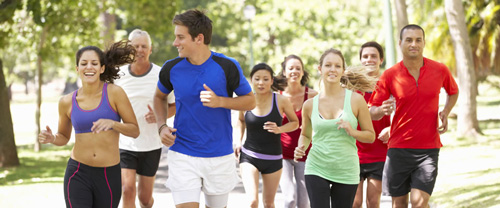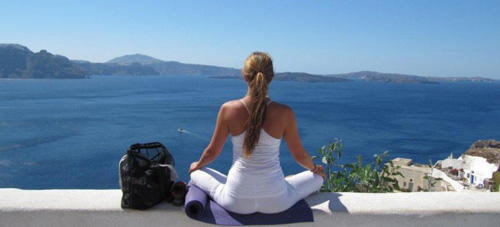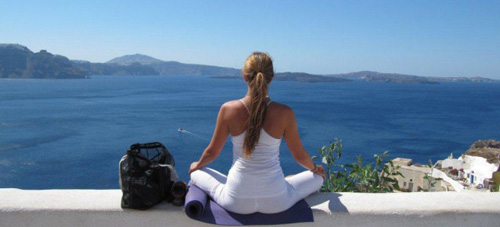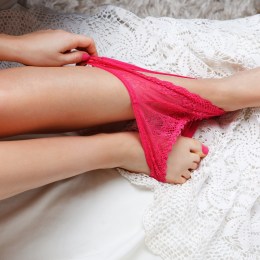The fitness landscape is shifting permanently, with a colossal socio-cultural evolution, according to Spafinder Wellness 365’s Top 10 Global Spa and Wellness Trends Forecast* for 2015.
 Fitness venues have become the important ‘third place’ for the pursuit of health, happiness and social connection, with lifestyle implications reaching far beyond the workout itself.
Fitness venues have become the important ‘third place’ for the pursuit of health, happiness and social connection, with lifestyle implications reaching far beyond the workout itself.
The community and social components surrounding fitness offerings – from the abundance of free yoga-in-the-park events to the explosion of neighbourhood boot camps, Pilates, yoga and spin classes – is at the core of how the health-conscious are living their lives today.
This uber-shift in turn is affecting how people dress, what they eat, who their friends are, who is in their professional network, which celebrities they follow, how they spa, how they raise their children, where they holiday, and more.
Given the unprecedented hours people work, and their paradoxically disconnected lives spent in front of screens, fitness studios and classes are becoming the place where increasingly rare human interaction takes place. And loyalty to instructors and relationships with classmates are fulfilling basic human needs to connect.
For today’s fitness fanatics, the beating heart of their social circle – their fitness ‘tribe’ – is in many ways, a life definer. Engaging in healthy behaviour together is habit-forming and, by most accounts, far more fun.
Gatherings like after-work drinks, all-night clubbing and boozy Sunday brunches have all been encroached upon by socialised fitness. While fitness-tracking mobile apps and streaming fitness classes have proliferated, they are by no means a replacement for good old-fashioned human contact and cheerleading.
Rather than tackle fitness in isolation, people get motivation, feedback and encouragement from togetherness. It’s especially helping the young, working woman demographic become empowered and embrace a healthy lifestyle.
International athletic footwear giant New Balance recently plugged into the growing social fitness trend with a multi-city Girls Night Out (#NBGNO) event to celebrate and connect like-minded active women.
After a warm-up, stretch and group run, the participating New Balance store event then offered women demonstrations with health experts, snacks, drinks and premium gift bags.
Events like these result in women finding group runs, new routes, hangouts, and then sharing their selfies across social media channels.
Fitness is now packaged as a party, often with DJs, bright lights and a rave-y vibe. For instance, alcohol-free morning dance parties like Morning Gloryville (born in London) or Daybreaker in Los Angeles let those who want to start the day the healthy way sweat alongside shiny, happy, like-minded people.
Another powerful social angle: the membership models of a Soulcycle or Flywheel ensure that diehards can find their cycle sisters and brothers at the dozens of locations in cities across the US when they travel.

A combination of forces – the breakdown of traditional communities, the rise in single-person households, extended work hours, urbanisation, and lives lived in front of screens – has led social scientists to argue that we’re living in an unprecedented new era of loneliness.
Globally, more people live alone than at any time in history, with single-person households increasing 50 percent in the last 15 years to become more than 15 percent of all households, a number forecast to skyrocket to 60 percent in 30 years.
The living-alone phenomenon is even more pronounced in cities. In Stockholm and Amsterdam, 60 percent of all households are single, and in Munich, Frankfurt, London, Paris, Manhattan and Washington DC, 50 percent. It’s rampant in the developing world, with India, China and Brazil’s single population growing fastest worldwide.

Technology has led to a breakdown in work-life barriers and the stressful, always-connected-to-work reality is making the 40-hour workweek obsolete.
The social media revolution means that we all spend countless hours in front of screens, being ‘alone together’.
Consider this: American adults spend almost 12 hours a day glued to screens/media, while Britons spend almost nine – more than either population sleeps on average.
In the 1980s, 20 percent of people reported they were lonely at any given time; that number has now doubled to 40 percent.
Women’s Economic Power Surging
While the passion for boutique fitness/yoga classes is rising among men, this trend is led by women, who have never had so much spending power to devote to their health and wellness.
Swedish economist Dr Kjell Nordstrom recently described our global future as an ‘urban and female Gaga,’ meaning that cities (where women are disproportionately represented) are fast overtaking countries as the powerhouse economic unit and that, increasingly, women will out-earn, and take more graduate education degrees than men.
The Boston Consulting Group forecasts that women will control 75 percent of all discretionary spending worldwide by 2028, with Nielsen estimating that at that point, women will out-earn men in the US.
From 2013-2018, women’s annual, global consumer spending will jump from $20 trillion to $28 trillion – with their earned income growing 40 percent faster than men’s annually.

As noted in the Spafinder Wellness 2013 Trend Report ‘Label Conscious Fitness’, fitness/yoga brands have been savvy in broadcasting what’s new and hot (and not), and what celebrities are doing to keep fit and beautiful.
This aspirational pursuit not only keeps fitness fun, it has transformed consumer behaviour, making boutique fitness class (and fashion) consumption a kind of retail therapy, where shopping the newest fitness craze provides pleasures/status similar to snagging that latest ‘it’ handbag.
This historic fusion of fitness and fashion is, of course, translating into big business. For instance, in the US the fitness industry is now worth $22.4 billion, with boutique fitness grabbing ever-bigger market share, to account for more than one in five fitness dollars spent.
And fitness is quite literally fashion: the craze for athletic and yoga apparel is outpacing the practice of fitness itself. While yoga participation grew 4.5 percent in 2013, sales of yoga apparel were up 45 percent.
With extreme exercise brand Crossfit, known for high-intensity strength and conditioning, participants are encouraged to get comfortable sweating on strangers.
Between the small mixed-sex class sizes, frequent chatty breaks and tribal community, both camaraderie and even romance are fostered.
Dozens of online videos attest to Crossfit’s share of marriage proposals by couples who fell in love amid kettlebell swings.

Due to the explosion of social fitness, working out is far more glamorous than ever before – it’s not just that yoga pants are worn like jeans, brands are designing for women who want to express themselves comfortably and creatively.
Big name designers like Tory Burch and Stella McCartney, as well up-and-comers dedicated to sexy-cool fitness fashion, are creating collections being worn from the studio to the street.
Active wear is suddenly being launched by brands like Norma Kamali, and unexpected brands such as boho-chic Free People and Urban Outfitters.
Fitness brands are deep into the fitness fashion game, too. Zumba-branded harem pants scream Zumba-lover. Pure Barre’s logo-donned headbands and their ‘new mummy’ sticky socks in blue or pink, inspire people to endorse their chosen fitness franchise.
Sassy graphic T-shirts labelling oneself a ‘Spiritual Gangster’ (by Carbon38) or plugging one of Crossfit’s many mantras, ‘Talk Less Lift More,’ are letting people make bold statements about fitness-as-their-life.
Sports heroes still continue to drive spending, fuelling the success of Olympian Kristi Yamaguchi’s fitness apparel line Tsu.Ya, designed for busy, on-the-go lifestyles, like her own as a mum.
The UK’s Sweaty Betty features sport-specific fashion for barre, cycle, dance, run, ski, swim, yoga and statement apparel. The retailer also offers in-store classes and at-home workout videos, fostering community.

The social fitness boom has bubbled over into the travel industry, illustrating once again how a fitness family becomes life, and influencing where people choose to holiday, and with whom.
While there has already been a steady uptick in wellness tourism over the decade (now a $494 billion global industry), loyalty to boutique fitness offerings has people travelling on fitness-themed retreats with their favorite instructor and class pals.
Another sign of the social wellness tourism phenomenon is the explosion of global yoga festivals. Modelled after epic, days-long rock festivals, events like Hanuman and Wanderlust are held in stunning natural settings around the world and attract thousands.
Beginners, yogis and even families are travelling to Colorado, California, Whistler in Canada, Australia, New Zealand, Chile and beyond for ‘mega-classes’ with famed yoga teachers (that include renowned musicians and speakers) for a mindful, celebratory experience.
‘Bring a friend or make a whole group of new ones’, Wanderlust’s website tells first-timers. Through the discovery of food, wine, craft-making, adventure activities, dancing, and, of course, yoga practice, connections are born in the fun.
The Standard Miami hosted Yoga Fest, a day-long retreat offering guests classes by elite instructors amid a spa, hydrotherapy and hammam playground.
Rustic yoga retreats like Silver Island, set on a private island in the Greek Aegean Sea, offer simple accommodation but, with only 10 guests per retreat, they create an intimate, friend-making experience.
Wellness holidays like Perillo’s Learning Journeys, a yoga volunteer program, are offered in destinations such as Costa Rica, Greece, Hawaii and India.
Travellers create an itinerary based on personal learning goals, and by helping out in a shelter or school they gain a meaningful connection to the local people.
Because of rising demand for transformative, communal travel, we’ve seen exponential growth for yoga and fitness travel specialists and tour operators, along with fitness/yoga retreat and festival rankings by popular travel publishers.
For people with predilections ranging from budget all-inclusive to women-only, vegetarian or Ayurvedic meals to ‘unplugged,’ to super-luxury, a new breed of specialist helps seekers find their tribes.
The Travel Yogi, a travel team that visits and handpicks all of their listings, aims to ‘help yogis unroll their mat on the beach, in the mountains, by the sea or under the stars’.
Yoga-themed combination tours are rising in every shape imaginable, from yoga safaris in Africa to yoga-surf cruises in the Galapagos and yoga-cooking retreats in Tuscany. Or for lovers of both happy hours and health, one can experience yoga and cocktails with celebrity instructor Tara Stiles at the W Hotels Retreat and Spa in the Maldives, or yoga-wine weekends at The Westin Verasa in Napa. ”””
Moving Into The Spa World
The ‘fitness family’ trend is also spilling over into day spas and stay spas in other ways, as they are upping their game by offering more boutique fitness weeks, fitness packages and outsourcing their fitness studios to branded yoga, barre and Pilates providers.
This is helping spas attract new customers along with the local market as their offerings become more focused on comprehensive, daily wellness rather than mere pampering.
The once often-isolating, hushed spa experience is getting significantly more social as well, as more spas and hotels rethink facilities and create more playful community spaces for both fitness and spa.
The Future of Tribal Fitness
This trend will continue to have profound ripple effects, as we increasingly favour day-long dressing in ‘athleisure’ over jeans, Facebook ourselves and our besties at a barre studio opening where devotees and celebrities are invited, spend happy hour on a hotel rooftop practicing yoga with co-workers, holiday with our favourite instructor at a yoga retreat – even meet our significant other at a cycling class.
We’ll see more branded gyms/studios with a global membership model, and more warm weather fitness/yoga festivals multiply in locales worldwide.
Children are part of the growing social fitness demographic. Yoga for kids and even programs like CrossFit Kids are creating the workout habit even before adolescence.
The once-boutique fitness pursuit is now there for the moving masses. Offerings like Treadmill Class, TRX and generic spin classes are available at community centres across the US, and free outdoor yoga or 2 YMCA events are making communal yoga more experiential and accessible.
Although an uber trend, social fitness is in its infancy. We predict exponential growth in, and for, businesses and brands that cater to people’s deep need for both social connection and a healthier lifestyle.
The fitness-and-human-connection-hungry demographic will only continue to grow as long work hours and global loneliness sharpen.
In 2015 and beyond this trend will expand beyond early adopters and go mainstream, as more people experience the value of sharing goals, values, support, get-healthy tactics and time with a fitness family.
About Spafinder Wellness 365 and its Top 10 Global Spa and Wellness Trends Forecast
Spafinder Wellness 365’s goal with the annual Trends Forecast is to provide the insight and information companies in the wellness industry will need to make sound decisions in the year ahead – and help businesses, consumers and the media understand how economic, cultural and social shifts will impact not only our industry, but also people’s lives.
In the sea of trend lists appearing each new year, we think our unique forecast stands out, taking an intense, research-driven view of what’s trending across the global wellness landscape from spa experiences to fitness, beauty, travel, nutrition and even workplace wellness. And unlike a standard slideshow, our 70-plus page report dives deep into the why, how and where each trend is developing.
The 2015 Spa and Wellness Trends Forecast is developed by a team of research analysts, editors and industry experts, and is based on ongoing surveys of the 20,000-plus spa, wellness and beauty providers in the Spafinder Wellness 365 Network, thousands of travel agents and hundreds of thousands of consumers – as well as interviews with industry leaders and extensive analysis of current market research.




